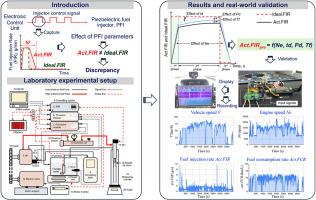How can measurement of injector control signal and piezoelectric injector parameters improve real-time fuel consumption monitoring
IF 2.7
3区 工程技术
Q2 ENGINEERING, MECHANICAL
引用次数: 0
Abstract
This paper introduces a new technique for measuring fuel consumption of Common Rail Direct Injection (CRDI) diesel engines accounting for Piezoelectric Fuel Injector (PFI) parameters: engine speed Ne, duty-time td, differential pressure Pd and fuel temperature Tf. The objectives were to experimentally investigate the impact of these PFI parameters on the Fuel Injection Rate (FIR), to establish a relationship between PFI parameters and FIR, and finally to design, build and validate a real-time fuel consumption measurement device on vehicle. First, laboratory experiments evidenced discrepancy between actual FIR and the ideal FIR derived from fluid flow principles. This is due to inertia force increase within the PFI (causing the Act.FIR to exceed the Ideal.FIR by 2.17 %), cavitation (leading to a 30.48 % decrease in Act.FIR compared to Ideal.FIR), decrease in volumetric efficiency of the high-pressure pump (resulting in a 4.49 % lower Act.FIR), as well as variations in fuel density. A model was proposed to calculate FIR from Ne, td, Pd and Tf, achieving a R-squared value of higher than 0.98. Finally, a real-time measurement system was designed and validated through vehicle tests, showing a measurement error of about 2 % between the predicted and measured total fuel consumptions. This study bridges the gap between theoretical modeling and practical application, offering a precise real-time solution for fuel consumption monitoring for eco-driving.

喷油器控制信号和压电喷油器参数的测量如何改善实时燃油消耗监测
介绍了一种利用压电式喷油器(PFI)参数(发动机转速Ne、占空时间td、压差Pd和燃油温度Tf)测量共轨直喷(CRDI)柴油机油耗的新技术。目的是通过实验研究这些PFI参数对燃油喷射率(FIR)的影响,建立PFI参数与FIR之间的关系,最终设计、制造并验证一种车载实时燃油消耗测量装置。首先,实验室实验证明了实际FIR与流体流动原理推导的理想FIR之间存在差异。这是由于PFI内惯性力增加(导致法案)。FIR要超越理想。FIR下降2.17%),空化(导致Act下降30.48%)。FIR与Ideal.FIR相比),高压泵的容积效率降低(导致Act.FIR降低4.49%),以及燃料密度的变化。提出了一种基于Ne、td、Pd和Tf计算FIR的模型,其r平方值大于0.98。最后,设计了一个实时测量系统,并通过车辆试验进行了验证,结果表明,总油耗预测值与实测值之间的测量误差约为2%。本研究搭建了理论建模与实际应用之间的桥梁,为生态驾驶油耗监测提供了精确的实时解决方案。
本文章由计算机程序翻译,如有差异,请以英文原文为准。
求助全文
约1分钟内获得全文
求助全文
来源期刊

Flow Measurement and Instrumentation
工程技术-工程:机械
CiteScore
4.30
自引率
13.60%
发文量
123
审稿时长
6 months
期刊介绍:
Flow Measurement and Instrumentation is dedicated to disseminating the latest research results on all aspects of flow measurement, in both closed conduits and open channels. The design of flow measurement systems involves a wide variety of multidisciplinary activities including modelling the flow sensor, the fluid flow and the sensor/fluid interactions through the use of computation techniques; the development of advanced transducer systems and their associated signal processing and the laboratory and field assessment of the overall system under ideal and disturbed conditions.
FMI is the essential forum for critical information exchange, and contributions are particularly encouraged in the following areas of interest:
Modelling: the application of mathematical and computational modelling to the interaction of fluid dynamics with flowmeters, including flowmeter behaviour, improved flowmeter design and installation problems. Application of CAD/CAE techniques to flowmeter modelling are eligible.
Design and development: the detailed design of the flowmeter head and/or signal processing aspects of novel flowmeters. Emphasis is given to papers identifying new sensor configurations, multisensor flow measurement systems, non-intrusive flow metering techniques and the application of microelectronic techniques in smart or intelligent systems.
Calibration techniques: including descriptions of new or existing calibration facilities and techniques, calibration data from different flowmeter types, and calibration intercomparison data from different laboratories.
Installation effect data: dealing with the effects of non-ideal flow conditions on flowmeters. Papers combining a theoretical understanding of flowmeter behaviour with experimental work are particularly welcome.
 求助内容:
求助内容: 应助结果提醒方式:
应助结果提醒方式:


